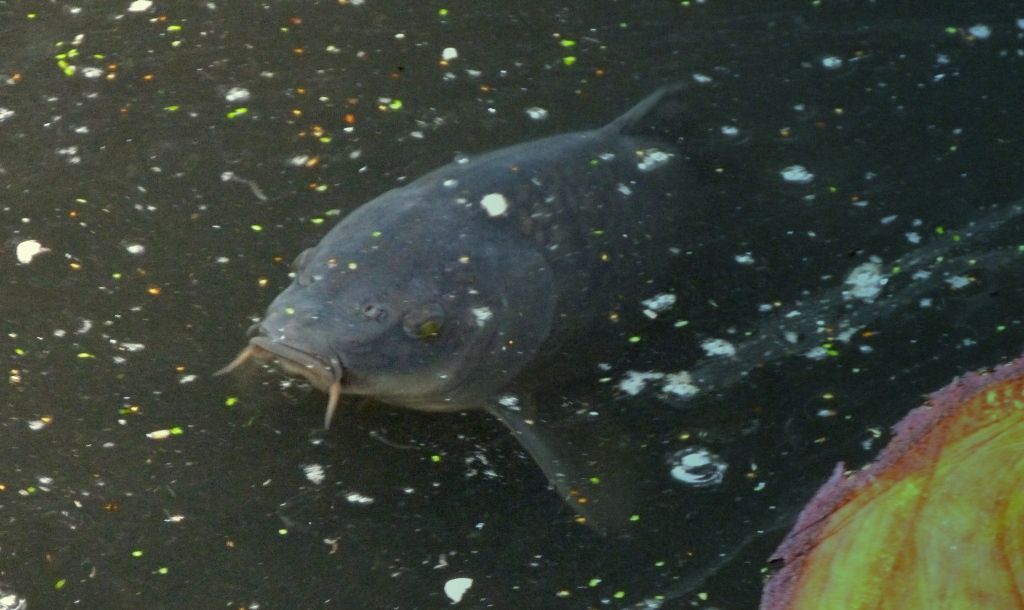It has been a hectic, tiring and very interesting few weeks! In my previous post, I explained that I was performing some bird surveys around campus to establish an idea of the biodiversity of the area. I have managed to gather data from each of my selected sites both at dawn and dusk, and just have to finish listening to my recordings of bird song from each survey to confirm I haven’t missed anything out.
However, before I tell you all about my findings, I must mention a few non-avian sightings during my survey period:
The Common Carp (Cyprinus carpio)

Common Carp on Campus
I saw these impressive fish in the shallows of lake as it tails off into the woodland, and took great delight in watching them from the bridge which leads towards the Agriculture buildings. The Common Carp is originally from Asia, and the only wild populations that remain are present in rivers which drain into the Black, Caspian and Aral Seas (FAO, 2012). Although the wild populations of this large fish is considered vulnerable to extinction due to hybridisation with domestic strains, it is also considered a potential pest where it has been introduced by man to many parts of the world (Fishbase, 2012).
The Red Fox (Vulpes vulpes)
The Red Fox has a long and interesting history associated with humans, unfortunately most of this history involves the hunting of this beautiful animal. It is the largest of the ‘true’ foxes, and has a very wide geographical range and despite their name, there are a number of colour mutations that can be found in this species which have made the use of its fur for clothing very popular.
I have always considered myself very lucky to see a fox, and every encounter makes my heart race. Foxes are wonderful animals to watch; more cat-like in the way they move than a domestic dog, and far more graceful, yet they have those innate canine behaviours which I can see are retained even by my Chihuahua. During my dusk surveys, I had two encounters with foxes; although it may have been the same individual. The first encounter was as I was entering the woodland where the lake tails off. It was a fleeting moment, but the fox looked fairly young and appeared healthy. The second encounter was in the Harborne car park. As I sat in my car trying to warm up after a chilly dusk survey, a fox came out from behind the building, and stopped in the car park to have a thorough scratch before slinking off towards Chemistry. Again, this was a young fox that seemed to be in good shape, so I hope to see it in the future!
The Common or European Toad (Bufo bufo)
One night, during my dusk surveys, I stumbled upon a young Common Toad (Bufo bufo) upon the pathway leading from the Agriculture building towards the lake. After a quick search with a torch, I found two more!
I would like to note that the Common Toad is listed as a priority species by the UK Biodiversity Action Plan (UKBAP), which identify species that require conservation to preserve the biodiversity of the UK (JNCC, 2012).
This a very long-lived species, with wild individuals able to reach 10-12 years old. They also tend to return to ancestral spawning grounds each Spring, so it is possible that the campus lake has long been an important breeding area for this species (ARC, 2012). I hope that I see more next year!
References and further reading:
The Amphibian and Reptile Conservation Trust (ARC) (2012) Common Toad URL: http://www.arc-trust.org/animals/common_toad.php [07/10/2012]
Food and Agriculture Organization of the United Nations (FAO) (2012) Cyprinus carpio URL: http://www.fao.org/fishery/culturedspecies/Cyprinus_carpio/en [05/10/2012]
Fishbase (2012) Cyprinus carpio carpio URL: http://www.fishbase.org/summary/Cyprinus-carpio+carpio.html [05/10/2012]
Joint Nature Conservation Committee (JNCC) (2012) UK BAP priority herptile species URL: http://jncc.defra.gov.uk/page-5166 [09/10/2012]


